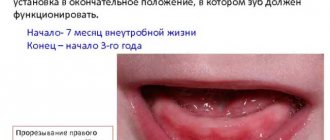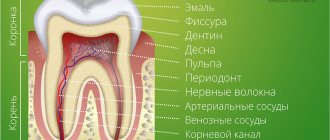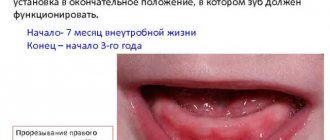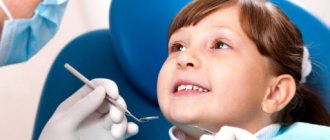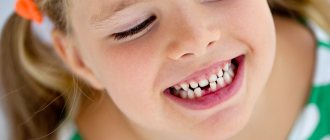How many teeth should a child have?
By the age of three, a child usually already has a full set of twenty primary teeth, and until about 6 years old, their number remains unchanged. Adolescents aged 13 to 18 years should normally have from 28 to 32 molars (depending on the presence of eights, which may erupt after 21 years or not appear at all).
How to help your baby
Any baby whose teeth are coming out needs increased parental attention, so adults are advised to:
- speak to the child only in calm and gentle tones;
- carry the baby in your arms more often;
- distract from toothaches through games.
Many children under one year of age are breastfed, and doctors advise not to wean the baby from the breast at this age, since latching on the breast helps calm the baby and helps him more easily survive the teething process.
You can reduce the pain during the appearance of primary incisors with the help of medications, but they should be used with caution and in case of emergency. Symptoms that cause severe concern (temperature above 38.5 °C, runny nose, making breathing difficult) are recommended to be eliminated exclusively under the supervision of a pediatrician.
What teeth appear first in children?
The rudiments of baby teeth and even some molars begin to form at the stage of intrauterine development, so modern diagnostic technologies make it possible to track this process and prevent some deviations. After birth, the first teeth usually begin to erupt when the baby reaches six months of age. This means he will soon be ready to eat more solid foods. In the vast majority of cases, the incisors appear first: as a rule, the lower central incisor becomes the “pioneer”.
Baby oral care
The need to take care of the oral cavity appears from the moment the child’s first teeth come out. Sufficient attention to oral hygiene will help prevent the development of many dental pathologies.
Prevention of dental diseases includes:
- Daily brushing of teeth. Until the age of one, experts recommend using a silicone toothbrush to clean the entire oral cavity. Parents should brush the teeth of a child under 4 years old, and children from four to eight years old should do the procedure independently under adult supervision.
- Rinsing your mouth after eating.
- Compliance with diet. The child's diet should include foods containing calcium, fluoride and other microelements. Until the age of one and a half years, it is undesirable for a child to consume chocolate or confectionery sweets, and snacks between meals are also undesirable.
Regardless of how many teeth your baby has lost by 8, 9, or 12 months, at the age of one year you should take him to a dentist for an oral examination.
Child's front teeth
Since a child’s front teeth usually erupt earlier than the rest, they can be used to track how the baby’s body tolerates this process. It can occur in different ways: some children are practically not worried, while others, on the contrary, experience stress and discomfort. Swelling of the gums at the site of the future tooth, itching and pain, as well as a slight increase in temperature are the main negative aspects associated with the appearance of the first teeth. When teething baby molars, children may experience runny nose and cough.
First signs of teething
You can recognize the imminent appearance of a tooth in a baby by the following external signs and changes in behavior:
- Crawling babies put their fingers and everything they see into their mouths. Their gums itch.
- Saliva floods my blouse and prevents me from sleeping at night.
- Sleep and appetite are disturbed.
- The gums swell and turn red.
- A couple of days before teething, a runny nose appears and sometimes a cough.
- The stool becomes liquid, mushy with a yellow, green tint.
- The temperature rises within acceptable limits.
- Whims, tears, crying are suddenly replaced by laughter and good mood. The child does not know what he wants, often asks to be held, and worries without his parents.
A baby, even at one or one and a half years old, experiences stress. Mothers need to understand and forgive the baby for his whims and disturbing dreams. Try to help during this difficult period for everyone. Do not get angry or yell at your daughter or son under any circumstances. Newborns do not yet know how to patiently endure toothache and discomfort and require the attention and care of their parents.
How do children's teeth grow?
There is no need to panic if the child’s teeth growth does not fit into the above scheme. A delay of 1 - 3 months is considered normal and is associated with the individual characteristics of the body. Children under one year of age often have teeth that do not appear on schedule or may not appear at all. In the latter case, you need to contact your dentist who will help identify the cause.
Factors influencing the eruption process
It is impossible to reliably determine how many teeth a particular child should have at 9 months, one and a half years, or another age period. The number of teeth and the nature of their eruption depend on the characteristics of the prenatal and postnatal development of the baby. Factors influencing the nature of prenatal development include:
- Mother's diseases. In children born from mothers with a heart defect, advanced caries, or who have had an infection (herpes, toxoplasmosis), the masticatory apparatus erupts two times slower than in a child born from a healthy mother.
- The course of pregnancy and childbirth. Incompatibility of Rh factors, prematurity, prolonged toxicosis in a woman and other complications during pregnancy are risk factors for disrupting the process of growth and formation of dental units.
- Nutrition for a pregnant woman. Children's teeth begin to form from the first trimester of intrauterine development. During this period, the expectant mother is recommended to consume foods containing sufficient amounts of calcium, fluoride and other elements necessary for the normal development of the dental apparatus.
- Infectious diseases of the newborn child.
- Heredity.
The quantity and quality of teeth that appear in a child in the 1st year of life are influenced by diet and diet, climate, and diseases suffered by the baby. The normality of teeth at 1 year is relative, but the complete absence of signs of teething at this age is an indicator of abnormal development of the child’s bite.
Tooth growth abnormalities in children
Unfortunately, the development and growth of teeth in children does not always occur as expected: there are a number of anomalies of various types that in one way or another affect the aesthetics and/or functionality of the teeth.
Causes of impaired growth and development of teeth:
- bad heredity;
- fetal injury during pregnancy or birth; intrauterine growth retardation, infections and so on;
- disruption of the endocrine system, thyroid dysfunction;
- lack of vitamins and minerals;
- mechanical, thermal and chemical injuries to teeth;
- bad habits in children that can affect the formation of teeth;
- lack of proper hygiene and poor diet.
Below is a table that describes the most common types of dental anomalies in children.
| Anomaly class | Description |
| Size of teeth | There are microdentia (too small teeth) and macrodentia (too large teeth). The anomaly can affect one or several teeth (and even the entire dentition). |
| Number of teeth | There is partial (lack of several teeth) and complete (absence of all teeth) adentia. Hyperdentia is a supernumerary set of teeth (usually in the second row). |
| Shape of teeth | Cone-shaped, barrel-shaped (Hutchinson's teeth), Pflueger's teeth (the neck is more developed than the coronal part). |
| Anomalies in the structure of enamel and dentin | Hypoplasia (spots and grooves on the body of the tooth), hyperplasia (tubercles, enamel drops, etc.), dentinogenesis imperfecta (violation of the structure and color of dentin). |
| Color irregularities | Enamel pigmentation (gray, black, amber enamel color). Most often it is caused by a disruption of the immune system during the prenatal stage of development. |
| Malocclusion | All types of dental malocclusions: mesial, cross, open, deep and so on. |
Despite the fact that some dental anomalies in children are quite serious, a timely visit to the dentist will help you avoid problems and maintain the health and beauty of your smile. If you let the situation take its course, unpleasant consequences will not keep you waiting.
What microelements are needed for teeth growth?
Vitamins and microelements are a necessary component for the development and normal functioning of the child and adult body. The formation of dental tissue cannot do without:
Fluorine
Strengthens enamel, makes incisors resistant to bacteria, the destructive effects of acids, and prevents caries. Fluoride is taken in tablets or drops when a deficiency is diagnosed. Enters the body with sea fish, nuts, grape juice, spinach, and most vegetables.
Toothpastes with fluoride are not approved for use by children under 4–5 years of age. Children aged 1.5–3 years swallow the tasty mass when cleaning their mouths, and an excess of the element is formed in the blood. For foolish children, choose toothpastes without fluoride to protect them from the negative consequences of hygiene procedures.
Calcium
It is the building material of infants' teeth. Without calcium, mineralization in tissues is impossible. After finishing breastfeeding, a one-year-old child should receive dairy products daily, greens and fish at least three times a week.
Vitamin K
Necessary for complete absorption of calcium and protein synthesis. Found only in natural dairy products (cottage cheese, sour cream and others).
Teething for young parents seems like an extremely difficult and nervous process. They prepare for it mentally, they are afraid of hysterics and hyperthermia.
Young and inexperienced parents do not need to worry or be negative. It is better to study the issue of dentition in infancy in order to arm yourself with knowledge and understand why the baby cries and is nervous. In this case, jaw development will be perceived as a normal physiological stage of growth, which will be experienced easily and quickly.
Children's dentition and everything about it
All parents carefully search for information about the correct number of teeth in the baby’s mouth in relation to his age. They are often interested in shape and size. It is worth remembering that the information received should not exempt the child from visiting the dentist for preventive purposes. Sometimes there may be congenital manifestations of anomalies in the oral cavity. We are talking about defects in the growth of teeth, as well as their incomplete composition in the upper or lower jaw.
Directly, baby teeth do not remain in the oral cavity throughout life, but only for a limited time, after which they fall out. After them, permanent ones grow up, which stay with the person for life, provided they are treated with care. Primary and permanent teeth have a number of differences, namely:
- The incisors of baby teeth have a more convex shape.
- Permanent teeth have a more developed root system than baby teeth, which fall out without causing discomfort.
- The enamel of primary teeth is thinner, but their pulp capsule is more pronounced. Baby teeth are more susceptible to caries.
The first teeth begin to appear at 4-5 months, but a delay of six months is not a violation. There is a certain sequence in which a baby’s first teeth appear:
- Incisors: central ones appear from 4 to 9 months, and lateral ones are expected from 8 months to 12 months.
- The first molars appear after the child is one year old.
- Clicks are expected from 1 to 2 years.
- By the age of 3, the second molars begin to emerge.
It is worth noting that at the age of three, a baby already has about 20 teeth in his mouth. Then, in their further growth, a pause is expected until the child reaches 5 or 6 years of age.


